Themes Part I
While traveling with a camera positively encourages us to photograph a wide variety of subjects—from landscapes and wildlife to busy cities and their own unique landmarks, at the same time, a collection of travel photographs will nearly always benefit if the images share a common theme, so creating a sense of continuity. Over the following pages we’ll explore the idea of themes—how to go about finding one and how to capture it successfully with your camera. Each time you travel to a new destination you can pick up on previously explored themes and add to your collection.
Many photographers naturally develop an identifiable style—some more definite than others—and this tends to give continuity. Style, however, is not easy to play with and manipulate. Deliberate attempts to change it or add to it can often end up looking mannered or gimmicky. A more plausible way of bringing continuity to the photographic record of a trip is to focus on one or more themes. Typically, these revolve around subject matter.
A particular destination may suggest its own storyline very easily, such as a Thai country town, as in the example here—immediately striking are the distinctive Buddhist temples, monks, cycle rickshaws, and graphics. Of course, these are the things that catch a Westerner’s eye—for a Thai they are normal and less immediately interesting. Another theme might be the journey itself—or one aspect of it. As we shall see later in the chapter, on an Aegean cruise on a newly built four-masted clipper ship, the work of the crew had a special interest. Large sailing ships are not so common, and the skills for dealing with the sails and rigging are now rare.

Cycle rickshaw
It is usually your specific destination that will suggest a theme that you can work into your photography. Introducing a theme will help to create a series of images that have continuity, so adding impact to the collection.
Finding a theme
Themes may suggest themselves as you travel around a region, simply by catching your eye. The Indian street graphics shown here are just such an example. But perhaps the most fruitful way of finding a theme is to follow your personal interests and whims. These could be in art, architecture, transportation, food, children’s toys, and games, anything.
I have a friend who is crazy about photographing reptiles, and over the years this has given him a very purposeful itinerary, as well as an outstanding collection of images. A more casual idea is the collection of hands at work, a few of which are shown here. This kind of shot crops up regularly in magzines and for that reason they make good stock photos Not all are interesting, but some are quite unusual, and when assembled together, they tend to enhance each other. The viewer makes connections and comparisons. Themes like these give direction and purpose to travel, even when they are just occasional asides.
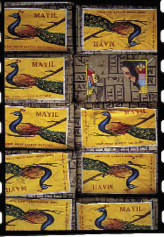
Indian graphics
Two of the characteristics of popular graphics in India are the vibrant use of color and painting by hand. Painted signs are idiosyncratic rather than slick, and the subject makes a rewarding theme.


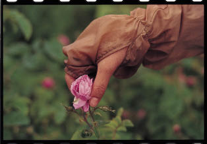
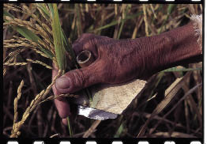
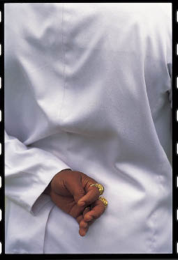
Hands
Three of a large collection of close-ups taken in many different situations and countries, wherever there are hands doing something unusual or interesting. At top, a Bulgarian girl picks roses for perfume, above a Japanese farmer harvests rice stalks one by one, and a Balinese priest at a temple ceremony.
The journey
There is a fundamental difference in approach between traveling to and traveling through. Time is a luxury that very few of us have as much of as we would like, and for the majority of people embarking on a trip, the idea is usually to get to the destination as quickly and painlessly as possible. This normally means by plane, and air travel is now one of the cheapest means. It is also typically organized, bland, and unexceptional. Add to this the strict security operating on aircraft and at airports and you have little incentive to include this part of the journey in your photography.
Which is a pity, because the process of travel is itself full of potential for experience, incident, and photography. There are, for example, the views en route. Carl Mydans, a veteran Life magazine photographer from the earliest days, thought that trains provided “excellent opportunities” because they “usually ride higher than the areas they pass through and the view from them is often commanding, surpassing what can be photographed from ground level.” Other means of transportation offer other, different windows on the land. Canals, for example, having been built for an older era in most countries, cut through countryside and urban areas against the grain of modern networks of road and rail. As Mydans put it, such transportation systems give “chances to … photograph the backyards—the underside of a country’s life that might be missed traveling by plane.”
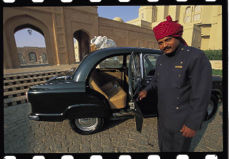
Ambassador
The Ambassador car, unchanged since the 1950s, is so much a part of India’s heritage that it is a worthy subject of photography on its own merits. This luxury model is part of a fleet belonging to a five-star hotel in Agra.
More than this, the journey may provide you with a behind-the-scenes look at the transportation system you are using. Trains, boats, and coaches each have their own lore, and are generally not as restricted of access to photography as are aircraft (this varies from country to country). Even if you do arrive at your general destination by air, you are likely to be traveling on by different means within the country or region. Take the opportunity to discover what is special about the vehicles you use, and their drivers.

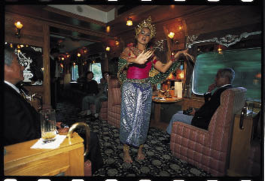
Orient Express
Run by the same company that owns the original, and still-running, Orient Express in Europe, this narrow-gauge train operates largely for tourists between Singapore and Bangkok. Life and activity on board makes a feature story for an American magazine, including Thai classical dance performance in the swaying dining car and the cramped but highly efficient galley operation at meal times.
Travel
Developing the theme introduced on the previous pages—of the journey as a subject worthy of becoming a part of the overall photography—there are some circumstances in which travel, more than destination, can be made the subject. One such occasion is a cruise, and in particular the cruise shown here, in the eastern Mediterranean on a four-masted schooner, newly built but to a traditional design. Unlike normal cruise liners this vessel, Star Flyer, carried only a hundred passengers and did so mainly under sail. Inevitably, despite the obvious attractions of the Greek island ports of call, such as Mykonos and Patmos, the workings of a sailing ship caught the attention of everyone on board. For some passengers, this was by far the main attraction. Technically interesting and supremely photogenic, the ship itself was the star of the week’s cruise.
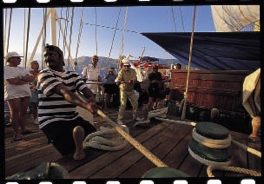

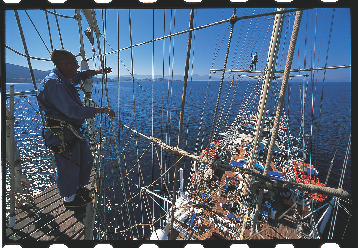

Street life
Towns and cities offer different kinds of photo opportunities—something of the landscape in overall views, and also a wonderful setting for people in all kinds of activity. Usually, the best way to deal with street life is to shoot unobserved, and there are a number of ways of doing this. The most direct is simply to shoot very quickly, quietly, and without fuss. This is easily enough said, and some great reportage photographers like Henri Cartier-Bresson have made this approach their hallmark, but it needs astute observation and fast reactions.
Try to anticipate what people will do next in any kind of situation—how they will react or look—because this will give you the edge in capturing the expression or movement. When you see the moment that you think is right, shoot without hesitating. Many people with a camera pause out of uncertainty before pressing the shutter, and lose the chance. You have nothing to lose by shooting.
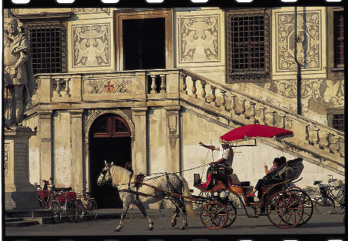
Horse and carriage
Tourists passing in front of the Palazzo dei Cavalieri in Pisa, northern Italy.
For this kind of photography, particularly in the street or other public place, like a market, a standard (efl 50mm) or wide-angle focal length is probably the most useful. A shorter focal length allows you to shoot from fairly close, which is helpful if there are a lot of passersby who might otherwise get in the way. The difficulty is that people can also see you, which may make it impossible to get a second shot that looks natural. One technique that can help is to use a wide-angle lens but compose the view so that the person you are photographing is off-center—in this way the camera appears not to be pointed directly at them.
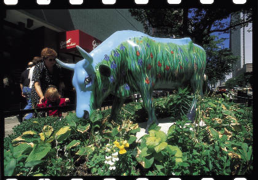
Chicago cow
One of more than 300 painted fiberglass lifesize cows placed around the city’s downtown loop. The “Cows on Parade” project was a huge publicity success for Chicago.
You can also make good use of long focal lengths. A telephoto lens lets you stand at a distance, and there is every chance that you will not be noticed if the scene is busy—and so can go on shooting naturally. A medium telephoto, such as the equivalent of 180mm for 35mm, is particularly good for “across-the-street” shots. Longer telephotos are more difficult to use because they are heavier, need faster shutter speeds to avoid camera shake, and draw attention. One technique is to sit quietly somewhere, and shoot from there. With all telephotos, there is a chance of passersby and vehicles crossing in front of the camera, so be prepared to shoot more frames than usual.
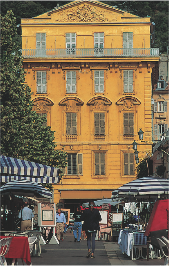

Old Nice
The Cours Saleya, combining fin-de-siecle architecture and market, typifies this old
French Mediterranean port.
Overviews
Cityscapes, and urban landscapes in general, often cry out for an establishing shot that makes some sense of the jumble and detail of buildings and streets. Viewpoint is the first thing to consider and tends to be more of a problem than in a natural landscape. You don’t have unrestricted access, and the layout of buildings always narrows the choices of clear views. Cities surrounded by hills or built on hills, such as San Francisco or Athens, have many good viewpoints, but they are the exception.

Watchtower
A watchtower built on a hill overlooking the town and castle of Bouillon in the Belgian Ardennes is locally well-known, and quite easy to find from local tourist literature.
Some of the most effective shots are those taken at a distance and at some height with a telephoto lens. Try the following:
•The top of any prominent tall building. Tall apartment buildings sometimes have open access; some public buildings may have purpose-built viewing galleries, but for offices and official buildings you would need advance permission.
•Any high ground, such as a hillside.
•The opposite side of a stretch of open ground or water, such as in a park, or on the other bank of a river.
Anticipate the lighting conditions that will give the effect you want. As with landscapes, a low sun in the early morning or late afternoon is usually more attractive than a high sun. Midday sunlight usually gives more contrast in a city than in an open landscape, as tall buildings cast large, strong shadows. Sunrise and sunset can be as effective as anywhere else. Cities also usually look good after dark, especially at dusk when there is still enough natural light to show the shapes of buildings.
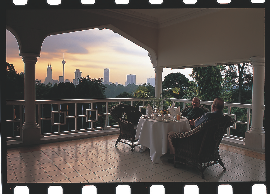
Kuala Lumpur
The skyline of Malaysia’s capital, including the Petronas Towers (for a time the world’s tallest building), becomes worthwhile as an image only through being framed here by the verandah of an old hotel.
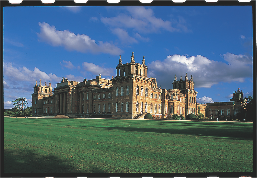
Blenheim
No elevated view of this famous English stately home, but a clear shot from across a huge lawn, taken with a shift lens racked up to make more of the sky.
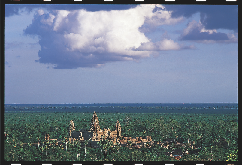
Angkor Wat
An isolated hill, Bakheng, less than a mile from the temple of Angkor Wat, gives a classic view—indeed the only overview possible without an aircraft.
The city at night
For a nighttime shot, cities are more brightly lit after sunset, and more so in winter than summer, when offices are still full. Different types of light—street lighting, neon displays, and public building spotlights—are switched on at different times. Check the scene the evening before to guarantee the timing for the brightest array of lights.
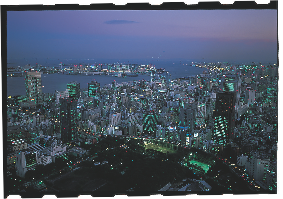
Markets
All destinations have their share of life, art, and nature; the full range of subjects for the camera, but a few stand out for their special relevance to the traveler. Markets are among these because of their variety, liveliness, and for offering an instant window into local culture. A common situation on arrival at a new destination is that of unfamiliarity. The guidebook sights apart, where do you find a concentration of people in a photographable situation? Markets are the reliable constant the world over. They are where people congregate to buy, sell, exchange, gossip, and they make an ideal entry point for photographing the community. If nothing else, an hour or two at the market is a kind of photographic exercise, a way of limbering up and brushing up your shooting skills if they’re a bit rusty.
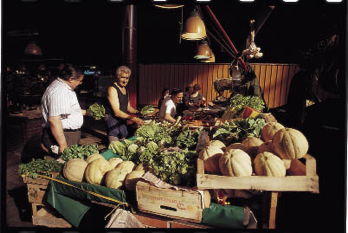
Mercato Centrale
Florence’s best-known food market is the Mercato Centrale, housed in a cast-iron hall dating back to 1874.
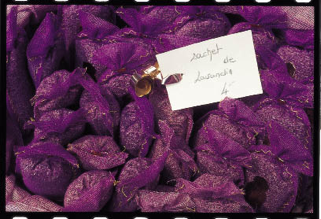
Close-up
The produce for sale is itself a potential subject for detail shots –here sachets of lavender in a Mediterranean French town, Moustiers-Ste-Marie.
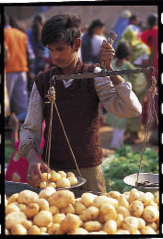
India
Most Indian food markets are open-air. In a crowded street in Gwalior, a vendor weighs potatoes on a handheld scale.
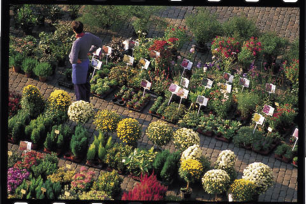
Elevation
The Grand Place in the heart of Brussels, arguably Europe’s most beautiful city square, hosts a flower market during the day. I asked permission to climb to a balcony of the Hotel de Ville for a more graphic view looking down.
Worship
Another reliable site where people congregate is—in most parts of the world—the local place of worship, whether a church, mosque, temple, or shrine. Like the market, there is usually a particular day and time for worship; unlike the market the activity is more serious and intense, and calls for more sensitivity on the part of the photographer—always make sure that you know in advance what you can and cannot do. There is always someone to ask.
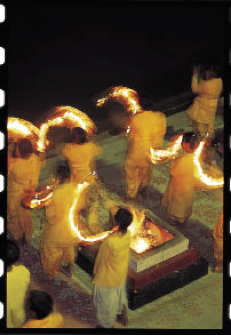
Rishikesh
Hindu: The evening Maha Aarti (great prayer ceremony) on the banks of the Ganges at Rishikesh, a notably sacred site where the river leaves the Himalayas.
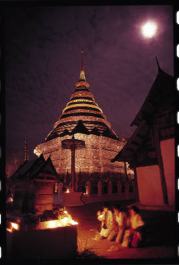
Northern Thailand
Buddhist: The year’s principal festival at an important old temple in northern Thailand, Wat Prathat Lampang Luang, takes place on the day of the November full moon, so it made sense to shoot at the time and place where this would be visible.
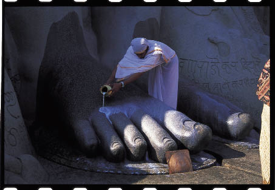
Gometashvera
Jain - A major pilgrimage site for Jain worshippers is the 56ft (17m) statue of Gomateshvara at Sravanabelagola, in India. The huge feet, over which milk is poured during a ceremony, convey the scale even more effectively than the entire statue.
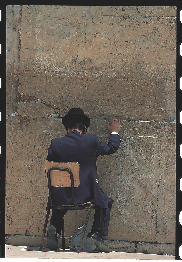
Wailing Wall
Jewish: Praying at the Wailing Wall, also known as the Western Wall, in the Old City of Jerusalem, has been a Jewish custom for centuries.
People
Undeniably, the theme with the greatest variety and complexity that presents itself before the camera when traveling abroad is “people.” There are various styles of images of people—posed portraits, reportage, people at work, people at play, and so on. All have their merits, but here we’re going to explore the candid, intimate photograph—when the subject or subjects (one or two usually create the most poignant images) are entirely oblivious to the camera and the photographer.
Images such as these are usually the most successful at capturing people in quiet, reflective contemplation or deep in conversation, and their lies in their ability to provide the viewer with an entirely natural, genuine perspective of people, which draws them into the picture.
To capture such personal, intimate moments you need to be outside the subject’s field of vision, yet be close enough to capture expressions. To do this you’ll need a telephoto lens in the 200–400mm range. Consider the physical surroundings in which the subjects are located—more often than not, including elements of this will add context to the moment and reinforce the intimacy, whether it’s someone sitting still while surrounded by a bustling crowd, or a couple holding hands while seated next to a river.

Reflection
A moment of quiet reflection for this young woman. The use of a telephoto lens has helped to blur the background making her profile easier to read.
It goes without saying, you should be very sensitive to your surroundings when taking photographs of people in a public space. While officially it may not be illegal, people may take offense if they see a long telephoto lens pointing at them. Use your judgement and be as inconspicuous as possible. Also remember that if you are intending to submit such images to stock agencies, and you don’t have a model release form signed by the subjects (difficult under most circumstances), such images will be advertised as “Not released.” To a certain extent this will restrict their usage, so making them less valuable.
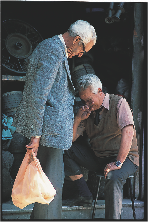
A private joke
Two men on an Athens’ street share a moment of restrained humor.

Taj Mahal
An Indian couple in an alcove of the Taj Mahal (hence the bare feet, as all visitors must remove their shoes), share an intimate moment. Their almost identical body postures reveals that they are much more interested in one another than in the world-famous monument, built appropriately as a token of love.